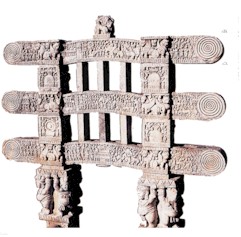| About Us | Site Map | Contact Us |
|
|
| Home | Schools & Teachings | Dharma Centers | Buddha & Bodhisattva Directory | Cosmos |
|
|
Buddhist Councils
|
The early Buddhist councils were mainly concerned with the purity of the faith and practice of the monastic community. For five hundred years after the Buddha's Nirvana, his teaching and discipline were retained in the memories of monks who periodically assembled to recite and review them. It was until the forth council that the valuable knowledge had finally been preserved with written format. The First Council The first council arose out of Maha Kashyapa's concern for the future of the Dharma when he was informed of the Buddha's Nirvana. In order to prevent the Buddha's teachings from disappearing, with the support of many of the senior monks, a council was called by Maha Kashyapa at Rajagrha immediately after the Buddha's Nirvana.
|
|
According to legend, this council comprised 500 arhats,or senior monks. The monk Upali was responsible for the composition of the Vinaya (monastic discipline). The monk Ananda was responsible for the Dharma (the sutra). With many memorizers of sutra and vinaya, as well as authorized commentators working in the community, all the contents had to be agreed upon among these 500 senior monks before they could be finalized in the council. The scriptures, however, existed only in an inchoate oral form. The Second Council The second council was held at Vaisali around a hundred years after the Buddha's Nirvana when a controversy broke out between a certain Yasa and the monks of Vajji. The purpose of this council was to settle a disagreement between these two groups of monks. The Vajjian monks resented the exclusive authority of the senior monks and wanted greater freedom in application of Vinaya. They adopted the practices that permitted storing salt in a horn, eating in the afternoon, drinking buttermilk after meals, and accepting gold and silver. With respect to the Teaching, these Vajjian monks did not agree that an Arhat was the highest attainment in the enlightenment path. They believed Arhats were still fallible and did not possess the extraordinary qualities of Buddhahood. Furthermore, the group of monks felt that their views represented the original spirit of the Buddha 's teaching. The above lax rules and different interpretation of the attainment levels were condemned and declared to be unacceptable by the council. The monks, however, refused to accept the decision of the council and proceeded to hold their own council elsewhere. They called themselves the "Majority Community" because they were sympathetic to the concern of the majority of the ordinary monks and the lay community, and had their support. The division was eventually led to the appearance of two major Buddhist traditions: Theravada (the Path of Elders) and Mahayana (the Great Vehicle). The Third Council  The conversion of Emperor Ashoka to Buddhism and the expansion of his kingdom led to the patronization of Buddhist activities. As a result of the encouragement a lot of non-Buddhists joined the order not because of their interest but for royal patronage. The newcomers who had retained their old beliefs and joined the order had introduced confusion to other Buddhist members. Therefore a council was needed to clarify the increasing danger to the purity of the Buddhism. A third council was called by King Ashoka at Pataliputra (Patna) about 250 B.C. to remove the beliefs and practices which were not part of the Buddha's teachings. The council also compiled the Buddhist teachings for the first time in three Buddhist canons (Tripitaka) and missionaries were sent out to various countries. The Tripitaka included Vinaya, Dharma, and Abhidharma. The new canon, Abhidharma, covering Buddhist Philosophy and Psychology, was essentially compiled to clarify some differences found in Vinaya and Dharma. The Fourth Council The fourth council was held in the first century at Jalandhar (in Kashmir) under King Kanishka, who had trouble with monks who gave instructions differing from others. In order to ensure the consistency of the contents, the various Buddhist interpretations of the Teaching were represented and reviewed. Since the objective of the council was limited to resolve differences, the focus of this council seemed to have been limited to the composition of commentaries disagreed upon at the time. And because only certain viewpoints seemed to have represented, it is generally considered as a sectarian synod. This council has never been recognized by Southern Buddhists. |
| About Us | Free Books | Site Map | Contact Us | ||
| Copyright © 1999-2020 Manjushri. All Rights Reserved. | ||
